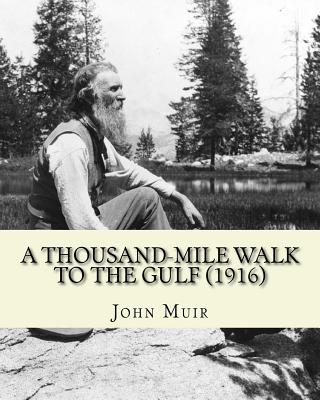A Thousand-Mile Walk To The Gulf (1916). By: John Muir, EDITED By: William Frederic Bade: Illustrated

A Thousand-Mile Walk To The Gulf (1916). By: John Muir, EDITED By: William Frederic Bade: Illustrated
Here is the adventure that started John Muir on a lifetime of discovery. Taken from his earliest journals, this book records Muir's walk in 1867 from Indiana across Kentucky, Tennessee, North Carolina, Georgia, and Florida to the Gulf Coast. In his distinct and wonderful style, Muir shows us the wilderness, as well as the towns and people, of the South immediately after the Civil War. John Muir ( April 21, 1838 - December 24, 1914) also known as "John of the Mountains", was a Scottish-American naturalist, author, environmental philosopher, glaciologist and early advocate of preservation of wilderness in the United States. His letters, essays, and books of his adventures in nature, especially in the Sierra Nevada of California and Nevada, have been read by millions. His activism helped to preserve the Yosemite Valley, Sequoia National Park and other wilderness areas. The Sierra Club, which he founded, is a prominent American conservation organization. The 211-mile (340 km) John Muir Trail, a hiking trail in the Sierra Nevada, was named in his honor. Other such places include Muir Woods National Monument, Muir Beach, John Muir College, Mount Muir, Camp Muir and Muir Glacier. In Scotland, the John Muir Way, a 130-mile-long route, was named in honor of him. In his later life, Muir devoted most of his time to the preservation of the Western forests. He petitioned the U.S. Congress for the National Park bill that was passed in 1890, establishing Yosemite National Park. The spiritual quality and enthusiasm toward nature expressed in his writings inspired readers, including presidents and congressmen, to take action to help preserve large nature areas.He is today referred to as the "Father of the National Parks"[4] and the National Park Service has produced a short documentary about his life. John Muir has been considered "an inspiration to both Scots and Americans".Muir's biographer, Steven J. Holmes, believes that Muir has become "one of the patron saints of twentieth-century American environmental activity," both political and recreational. As a result, his writings are commonly discussed in books and journals, and he is often quoted by nature photographers such as Ansel Adams. "Muir has profoundly shaped the very categories through which Americans understand and envision their relationships with the natural world," writes Holmes. Muir was noted for being an ecological thinker, political spokesman, and religious prophet, whose writings became a personal gui
PRP: 70.84 Lei
Acesta este Pretul Recomandat de Producator. Pretul de vanzare al produsului este afisat mai jos.
63.76Lei
63.76Lei
70.84 LeiLivrare in 2-4 saptamani
Descrierea produsului
Here is the adventure that started John Muir on a lifetime of discovery. Taken from his earliest journals, this book records Muir's walk in 1867 from Indiana across Kentucky, Tennessee, North Carolina, Georgia, and Florida to the Gulf Coast. In his distinct and wonderful style, Muir shows us the wilderness, as well as the towns and people, of the South immediately after the Civil War. John Muir ( April 21, 1838 - December 24, 1914) also known as "John of the Mountains", was a Scottish-American naturalist, author, environmental philosopher, glaciologist and early advocate of preservation of wilderness in the United States. His letters, essays, and books of his adventures in nature, especially in the Sierra Nevada of California and Nevada, have been read by millions. His activism helped to preserve the Yosemite Valley, Sequoia National Park and other wilderness areas. The Sierra Club, which he founded, is a prominent American conservation organization. The 211-mile (340 km) John Muir Trail, a hiking trail in the Sierra Nevada, was named in his honor. Other such places include Muir Woods National Monument, Muir Beach, John Muir College, Mount Muir, Camp Muir and Muir Glacier. In Scotland, the John Muir Way, a 130-mile-long route, was named in honor of him. In his later life, Muir devoted most of his time to the preservation of the Western forests. He petitioned the U.S. Congress for the National Park bill that was passed in 1890, establishing Yosemite National Park. The spiritual quality and enthusiasm toward nature expressed in his writings inspired readers, including presidents and congressmen, to take action to help preserve large nature areas.He is today referred to as the "Father of the National Parks"[4] and the National Park Service has produced a short documentary about his life. John Muir has been considered "an inspiration to both Scots and Americans".Muir's biographer, Steven J. Holmes, believes that Muir has become "one of the patron saints of twentieth-century American environmental activity," both political and recreational. As a result, his writings are commonly discussed in books and journals, and he is often quoted by nature photographers such as Ansel Adams. "Muir has profoundly shaped the very categories through which Americans understand and envision their relationships with the natural world," writes Holmes. Muir was noted for being an ecological thinker, political spokesman, and religious prophet, whose writings became a personal gui
Detaliile produsului








